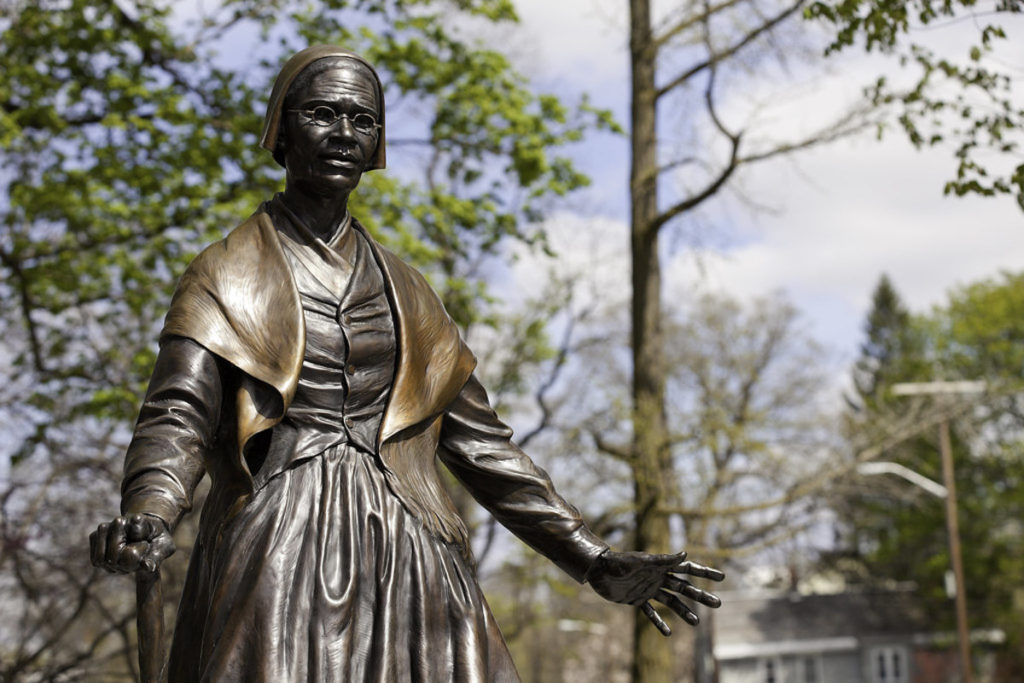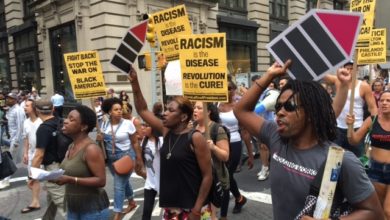This article is part of Liberation’s commemoration of Black History Month, 2021.
May I say a few words? I want to say a few words about this matter. I am a woman’s rights. I have as much muscle as any man, and can do as much work as any man. I have plowed and reaped and husked and chopped and mowed, and can any man do more than that? I have heard much about the sexes being equal; I can carry as much as any man, and can eat as much too, if I can get it. I am as strong as any man that is now. As for intellect, all I can say is, if women have a pint and man a quart – why can’t she have her little pint full? You need not be afraid to give us our rights for fear we will take too much, for we can’t take more than our pint’ll hold. The poor men seem to be all in confusion, and don’t know what to do. Why children, if you have women’s rights, give it to her and you will feel better. You will have your own rights, and they won’t be so much trouble. I can’t read, but I can hear. I have heard the Bible and have learned that Eve caused man to sin. Well if woman upset the world, do give her a chance to set it right side up again. The Lady has spoken about Jesus, how he never spurned woman from him, and she was right. When Lazarus died, Mary and Martha came to him with faith and love and besought him to raise their brother. And Jesus wept – and Lazarus came forth. And how came Jesus into the world? Through God who created him and woman who bore him. Man, where is your part? But the women are coming up blessed be God and a few of the men are coming up with them. But man is in a tight place, the poor slave is on him, woman is coming on him, and he is surely between-a hawk and a buzzard.
Sojourner Truth speech 1851, Akron, Ohio. Published by Marius Robinson in the Salem Anti-Slaver Bugle a few weeks after the speech. (The Sojourner Truth Project).
Sojourner Truth, born into slavery in New York as “Isabella Baumfree” in 1797, was one of the most important abolitionists and feminists of the nineteenth century.
Truth’s life is extraordinary for her fierce independence, her escape from slavery, her public life as a Methodist preacher, her lobbying on behalf of the Union cause and freed slaves during the Civil War, and her ceaseless work to end slavery and win all women the right to vote.
While Truth is known and celebrated by millions of people around the world today, one lesser-known period in Truth’s life was her time spent in the abolitionist intentional community that formed in what is now Florence, Massachusetts.
Florence is a village within the City of Northampton and evolved out of a radical abolitionist endeavor known as the Northampton Association of Education and Industry, which existed from 1842 to 1846.
In today’s language, the NAEI would be known as a commune or a workers’ cooperative. Profits were shared and Sojourner Truth personally directed the collective laundry, where she supervised white men and women workers. The NAEI was a multinational group of Black and white families who came together to freely live, produce, and organize. The Association ran a silk mill, farms, and had common facilities where families ate and socialized together.

Photo credit: Lynne Graves (CC BY-ND 2.0)
Black leaders like David Ruggles and Sojourner Truth, as well as Black families fleeing slavery, were drawn to this community for its political commitment to abolition and full equality for Black people, and for its dedication to putting those ideals into practice locally.
Although the NAEI only lasted a little over four years, activists like Truth remained in the area for over a decade. Florence served as a “home base” for Truth during her national speaking tours and became a hub for abolitionists from Boston like William Lloyd Garrison. After the NAEI dissolved, the silk industry remained, there were still home ownership opportunities for Black families, and some of the political values that inspired the NAEI persisted. The City of Northampton served as an endpoint in the Underground Railroad until 1850.
In 1857, Truth left Massachusetts and relocated to a Quaker community called Harmonia after 14 years of living in Florence. She spent the rest of her life fighting for the rights of Black people and women; actively supporting freed Black slaves during the Civil War through her work with the National Freedman’s Relief Association, meeting with President Lincoln, and speaking in favor of women’s suffrage. In 1872, Truth participated in a suffragist action with hundreds of other women and was turned away from the voting booth. She passed away at the age of 86 at her home in Battle Creek, Michigan on November 26, 1883.
Sojourner Truth’s legacy lives on in the militant struggles for Black and women’s liberation, and the fight for justice everywhere. Her bold challenge would shape and inspire the feminist and anti-racist movements in the United Sates and beyond for decades, anticipating the idea of intersectionality pioneered by Kimberlé Crenshaw and the Black socialist feminists in the Combahee River Collective. They write:
There have always been Black women activists – some known, like Sojourner Truth, Harriet Tubman, Frances E.W. Harper, Ida B. Wells Barnett, and Mary Church Terrell, and thousands upon thousands unknown – who have had a shared awareness of how their sexual identity combined with their racial identity to make their whole life situation and the focus of their political struggles unique.
Truth’s legacy also lives on locally in Western Massachusetts. The David Ruggles Center for History and Education continues telling the story of Florence’s radical history and Sojourner Truth’s time there. The Sojourner Truth Memorial honors her life in Florence, and the Sojourner Truth School for Social Change Leadership in nearby Holyoke, Massachusetts, educates new generations of activists with Truth’s legacy in mind.
The school offers by-donation classes taught by local activists on topics such as reparations for Black America, movement-building and the arts, fighting anti-Semitism and Islamophobia, and raising anti-biased children, among others.
Sojourner Truth’s message of justice and equality for all oppressed people in the United States has increased relevance today, and Western Massachusetts should be proud that Truth decided to call this place home for over a decade, as she set off to change the world.
References
1851 speech text: The Sojourner Truth Project
The Combahee River Collective Statement: https://americanstudies.yale.edu/sites/default/files/files/Keyword%20Coalition_Readings.pdf
The David Ruggles Center on the Northampton Association of Education and Industry: https://davidrugglescenter.org/northampton-association-education-industry/
The David Ruggles Center on Northampton’s role in the Underground Railroad: https://davidrugglescenter.org/the-underground-railroad/
The David Ruggles Center on Sojourner Truth’s life and work: https://davidrugglescenter.org/sojourner-truth/






